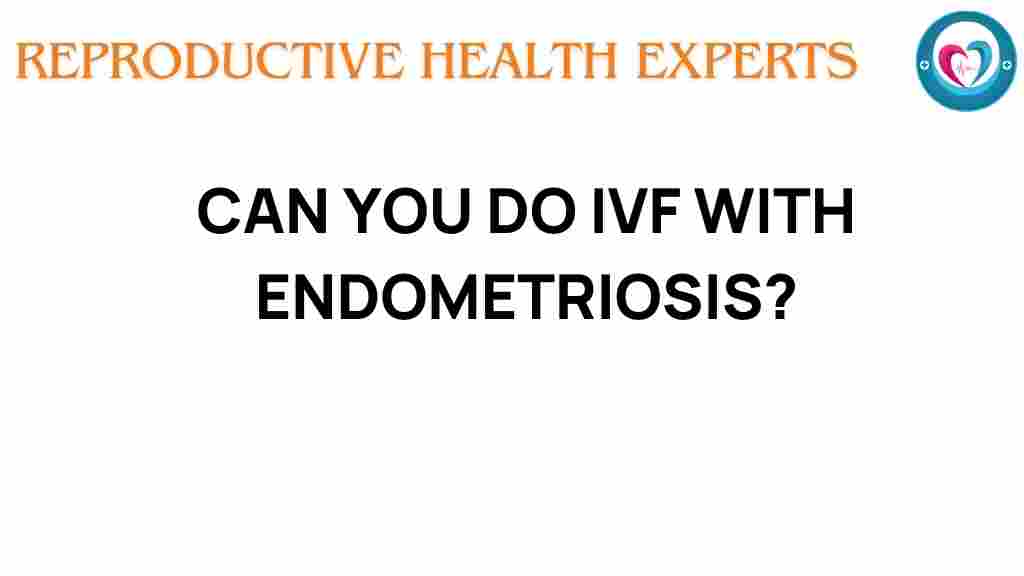Infertility is a challenge that affects many women around the world, and for those diagnosed with endometriosis, the journey can be particularly complex. Endometriosis is a condition where the tissue similar to the lining inside the uterus grows outside of it, leading to pain, hormonal imbalances, and infertility. Fortunately, advances in reproductive health have made assisted reproduction techniques, such as in vitro fertilization (IVF), viable options for many women struggling with infertility. This article explores the intersection of IVF and endometriosis, providing insights into how women can navigate their fertility treatment to achieve success.
Understanding Endometriosis and Its Impact on Fertility
Endometriosis can significantly affect a woman’s reproductive health. The condition can lead to:
- Formation of adhesions and scar tissue that can obstruct the fallopian tubes.
- Hormonal imbalances that disrupt the menstrual cycle.
- Ovarian cysts (endometriomas) that can affect egg quality.
These factors contribute to infertility, making it crucial for women with endometriosis to understand their condition and explore their options for fertility treatment. IVF can be an effective solution, helping many achieve successful pregnancies.
Step-by-Step Process of IVF for Women with Endometriosis
For women with endometriosis considering IVF, the process typically consists of several key steps:
1. Initial Consultation
The first step involves scheduling an appointment with a fertility specialist. During this consultation, the doctor will review your medical history, perform a physical examination, and may conduct tests such as:
- Ultrasound imaging to assess the ovaries and uterus.
- Blood tests to evaluate hormonal balance.
- Laparoscopy to visualize and possibly treat endometriosis.
2. Ovarian Stimulation
Once endometriosis is assessed and treated if necessary, the next step is ovarian stimulation. This involves the use of fertility medications to stimulate the ovaries to produce multiple eggs for retrieval. Monitoring through blood tests and ultrasounds is critical during this phase to ensure the body’s response is optimal.
3. Egg Retrieval
When the follicles are mature, a minor surgical procedure is performed to retrieve the eggs. This is done under sedation and involves using a thin needle guided by ultrasound to extract the eggs from the ovaries.
4. Fertilization and Embryo Culture
Once the eggs are retrieved, they are fertilized with sperm in the lab. After fertilization, the embryos are cultured for several days until they reach a stage suitable for transfer.
5. Embryo Transfer
The final step in the IVF process involves transferring one or more embryos into the uterus. This is typically a simple procedure that requires no anesthesia.
6. Pregnancy Test
About two weeks after the embryo transfer, a pregnancy test is conducted to determine if the procedure was successful.
Troubleshooting Common Challenges in IVF with Endometriosis
Women with endometriosis may face unique challenges during their IVF journey. Here are some common issues and tips for overcoming them:
1. Poor Egg Quality
Endometriosis can affect egg quality, which is crucial for successful fertilization and embryo development. To improve egg quality:
- Consider supplements such as CoQ10 and Vitamin D to support ovarian health.
- Maintain a healthy lifestyle with a balanced diet and regular exercise.
- Discuss with your doctor about potential treatments to improve egg quality.
2. Hormonal Imbalances
Hormonal balance is essential for a successful IVF cycle. If you have hormonal imbalances due to endometriosis:
- Work with your fertility specialist to monitor hormone levels closely.
- Consider treatments to regulate hormones, such as the use of birth control pills prior to IVF.
3. Emotional Stress
The IVF process can be emotionally draining, especially for those dealing with infertility and endometriosis. To manage stress:
- Seek support from friends, family, or support groups.
- Consider counseling or therapy to help navigate the emotional aspects of IVF.
- Practice relaxation techniques such as yoga or meditation.
Success Rates of IVF with Endometriosis
Many women with endometriosis successfully conceive through IVF. Success rates can vary based on several factors, including:
- The severity of endometriosis.
- Age and overall reproductive health of the woman.
- Quality of the embryos created during the IVF process.
Research indicates that while endometriosis may reduce the chances of natural conception, many women still have favorable outcomes with IVF. Discussing your specific situation with a fertility specialist can provide a clearer picture of your chances for success.
Conclusion
Women with endometriosis can navigate the complexities of IVF and achieve their dreams of parenthood. While the journey may present challenges, understanding the process and preparing for potential obstacles can empower women on their path to reproductive health. With advances in assisted reproduction, including IVF, many women with endometriosis are finding success in their fertility treatments.
If you or someone you know is facing infertility due to endometriosis, consider seeking professional help and explore the possibilities that IVF offers. For more information on endometriosis and fertility, visit Endometriosis.org or consult with your healthcare provider.
For further insights, tips, and support on your journey through IVF, check out our resource section here.
This article is in the category Fertility and created by ReproductiveHealthExperts Team
